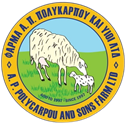The church, which has three aisles, is of the early 18th Century but, it appears to have been previously built, around the 14th century. Segments of the mediaeval church (two small chapels) are incorporated in the more recent church (in its north-east and south-east corners). In the niche of the north-east chapel, which seems to have been a chapel also used as a burial, there is a fairly worn-out fresco of the Virgin Mary sitting on a throne along with little Jesus. In 1960 the Antiquities Department made efforts for the conservation of this fresco but, unfortunately the removal of plaster was unsuccessful.
The traces of the other parts of the monastery (monks' cells, etc) have disappeared. From the information we gathered it seems that when the priest officiated in the central church, the small chapels were also officiated, as well as during the Holy Communion.
All the necessary things for a liturgy and for servicing the faithful can be found inside the church. The meagre and worn-out icon screen, the Psalters, and the few wooden stools are present in the interior of the church, in which a liturgy is conducted about 10-12 times a year. A mass takes place every time it called the day of the Blessed Virgin Mary.
However, there are some other remains of old churches in the region, such as the country church of Archangel Michael, which was declared as an "B" status ancient monument by the Antiquities Department. Moreover, the country church of Saint Helen is about 3 km far from the village in a strangely coulee. There isn't anything else or any other information regarding these churches.
Church and Chapelskelvege2023-07-21T14:20:14+03:00
The first one is that of Saint John the Theologian’s and it is the village’s central church. Saint John the Theologian’s day is on the 26th of September, the day of John the Theologian’s “metastasis” (departure) as it is called by the inhabitants of the community in Prastio Avdimou. It is located at the centre of the village. It was built in 1900 and it is of Gothic style. Externally, it is made of stone and has a roof and, internally, the church is flat. The portable icons of the saints in the icon screen are the nave’s riches. The wood-cut icon screen, separating the High Altar from the rest of the temple, is enough to attract visitors. Portable icons of the Saints frame the icon screen. The church has a capacity of 160 persons.
The other church, the second one with a big history is the one of Panagia Diakinousa. Further north than these relics, in an isolated valley, the church of an old, small monastery that was dedicated to “Panagia Diakinousa” (the Moving Virgin Mary) is extant. It was named so because, according to tradition, the inhabitants used to see the Virgin Mary coming out of the church and walking. Always according to tradition, at the time that Apostle Paul was preaching Christianity in Pafos, the people were scared of Judaism and so had to move to the north, where they found a safe place to build a church that later became a large Monastery and had several monks living in it. In an age when the Plague (some illness) was killing the village’s inhabitants, the Virgin Mary chased the Plague out of the village where She firmly stepped on a large rock, leaving Her footprint on it; the rock was named “Pathkia tis Panagias” (Footprint of the Virgin Mary) and the name remained until today and also the rock with the foodprint and you can see them if you go there until nowdays,and they say that is the same rock that Virgin Mary stepped. Ever since then the illness disappeared from the village.
